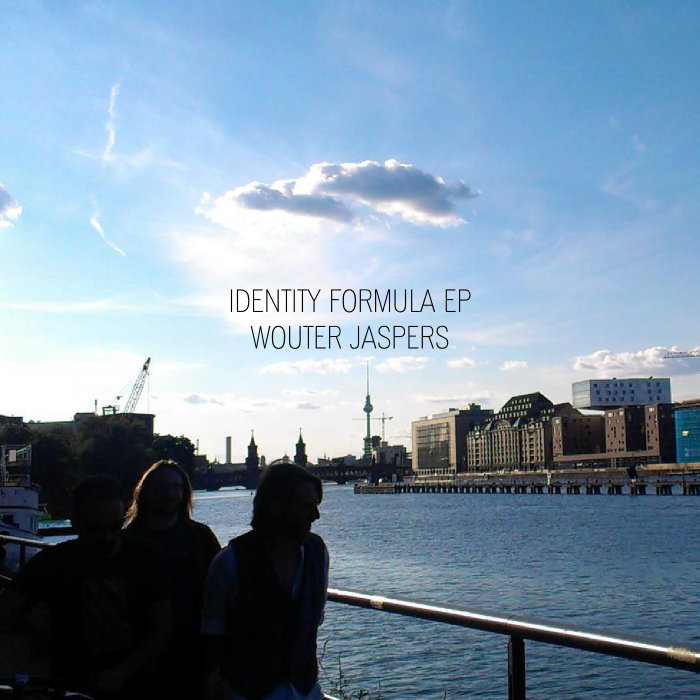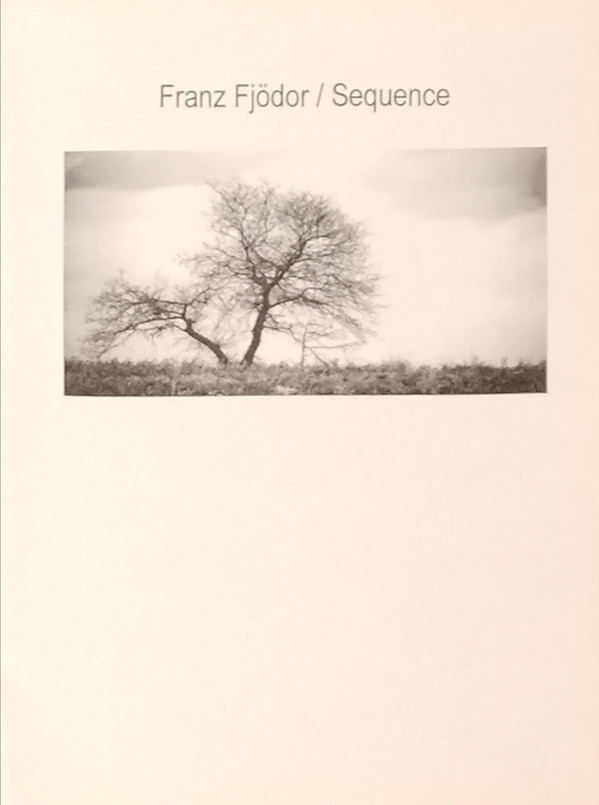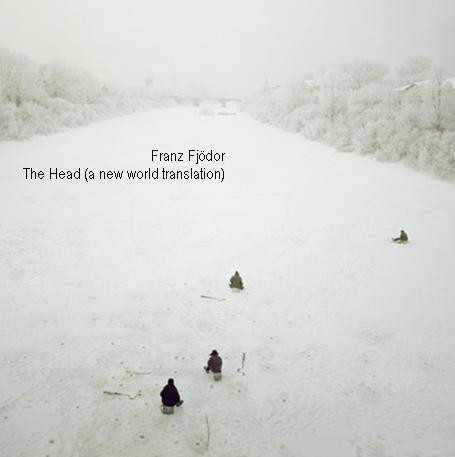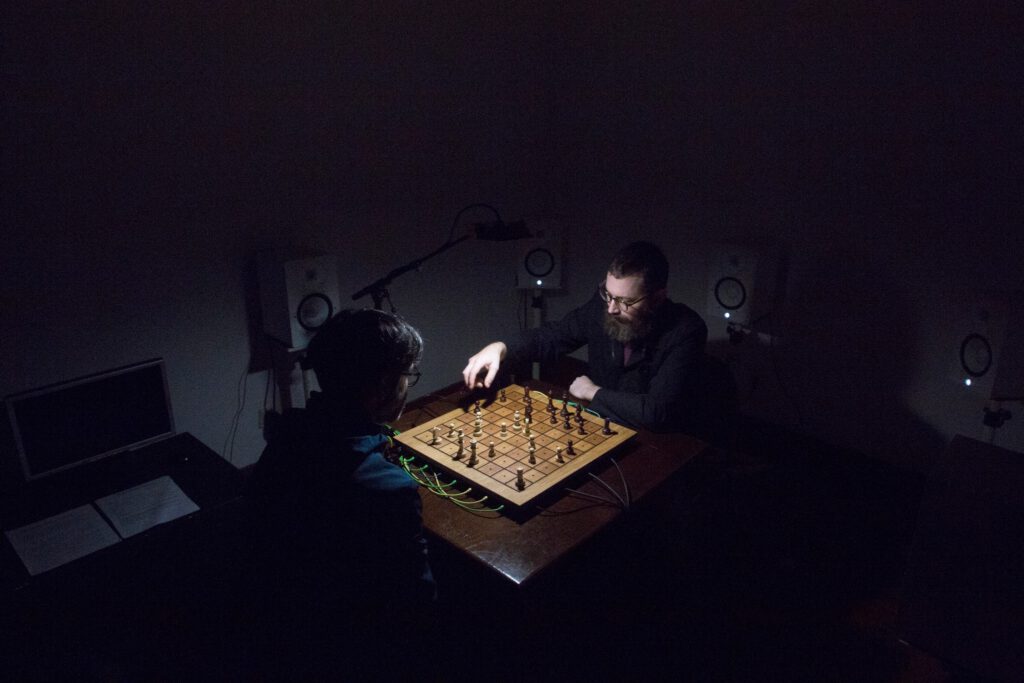
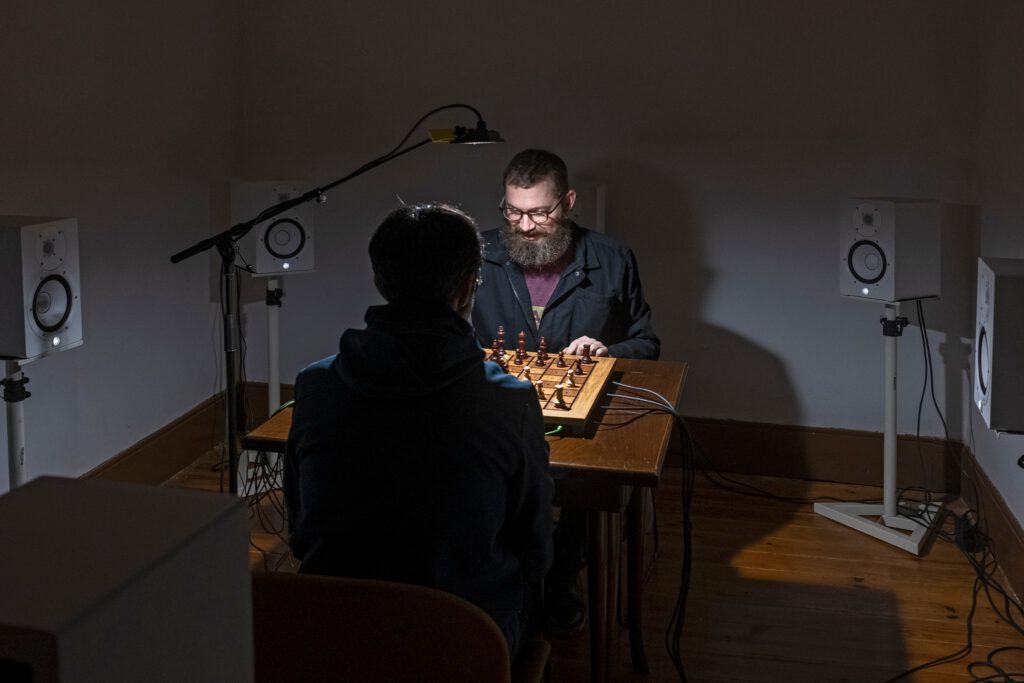
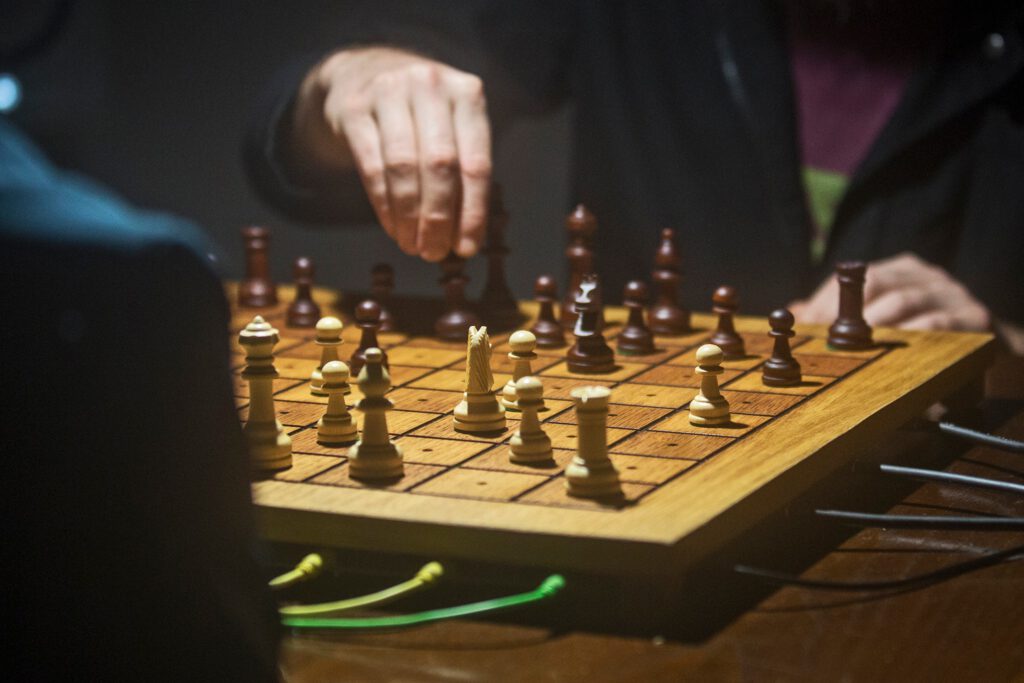
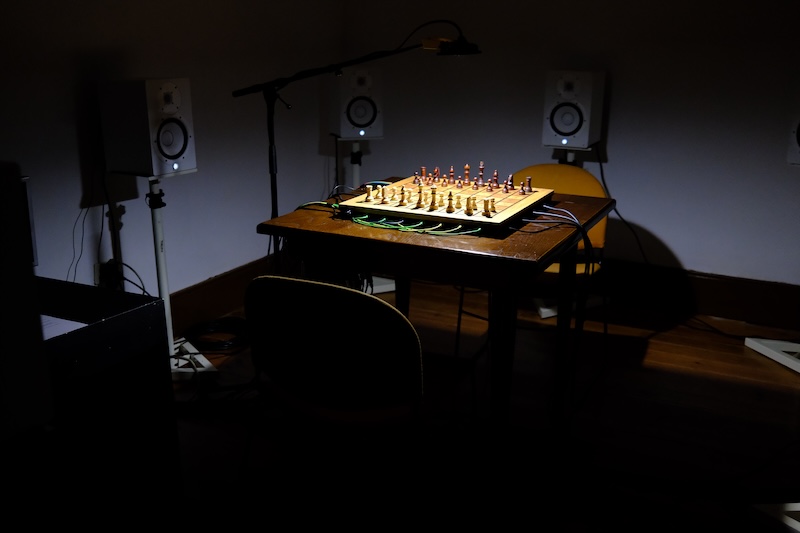
indeterminate structures
Playful competition, strategic composition.
Photo by Rui Pinheiro & Marta Bento
Indeterminate Structures is a sound installation exploring ways of gamification of music and the complex interplay of order, chance, and freedom in the musical (composition) process. Using a prepared chessboard equipped with light sensitive sensors allowing the incoming sound sources to be distributed over 8 speakers, visitors are invited to perform any of the written-out compositions in chess notation or simply play games with one-another, resulting in a re-creation of John Cage’s Reunion performance. The musical source material for this installation are both released and unreleased works taken from my archive and processed for octophonic spatialisation.
Indeterminate Structures was presented for the first time at Sonoscopia in Porto, Portugal for the Sem DEsorganizado Festival on December 8-9 2023. Audiovisual recordings of this work will be released in 2024, including live performances of my new works Sunday Afternoon – for one player and electrified chessboard (2023) and Shadow-play – for two players and electrified chessboard (2023).
A review of this sound installation and Wouter’s talk at the festival, including some nice pictures can be found at therimasebatidas.pt website.
For more information, please scroll down.
Indeterminate Structures (2023)
By Wouter Jaspers
Introduction
I have been captivated by the world of found sound, field recordings, and the element of chance in musical composition, ever since starting to make music in my teenage years. My musical journey has always been about exploring the unnoticed sound-world that is all around us; I find music in the everyday. The ambient noises and subtle harmonies that often go unnoticed serve as the foundation of my compositions, which are rooted in reality and at the same time go beyond the mundane.
Field recordings are integral to my work, acting as aural snapshots of specific moments in time and space. Whether it’s the unnerving sound of a geigercounter while riding towards Chernobyl1, the rustling of leaves in a forest, a walk up a Japanese mountain or the hum of a city at night, these sounds provide a rich tapestry that I weave into my works. This approach results in music that is constantly evolving and reflective of the chaotic beauty of life itself. In essence, my musical interests lie in the exploration of the sonic world around us, the transformation of ordinary sounds into music, and the embrace of chance as a creative force.
Since 2019 I have been focussing my artistic attention on radio works for symphonic live performances culminating in a research project surrounding radio frequencies called “Arctic Survey Music” in 2021 and my live composition “Antennenfeld” in 2022, never knowing exactly which sounds will appear from the ether, working with what comes up as it comes up. This shift of interest from strictly performing electronic and electro-acoustic music goes hand in hand with my search to find new collaborative and playful structures to let my audience re-mix my work, play with its materiality and find a deeper understanding of it by playing with it. This is how I got interested in exploring game-like structures for collaborative music creation.
Standing on the shoulders of Giants
With a quick introduction of sonic works involving game-like elements from the past, I want to highlight certain features that have inspired my own work. One of the earliest examples of game-based compositional praxis is the use of dice games in the 18th century. Composers like Johann Philipp Kirnberger and W.A. Mozart created “Musikalisches Würfelspiel” or musical dice games2, where measures of music were selected based on the roll of a dice3. This introduced an element of chance into the composition process, resulting in a unique piece of music each time the game was played.
For my research into game-like structures and playful manners of allowing my audience to remix my work I chose chess as my main vehicle to start my investigation. Besides the fact I like to play the game, chess and music share a common language of structure, pattern, and variation. Both require strategic thinking, pattern recognition, and creativity. Even the way that chess is being notated reminds me of musical practices.
This is not the first time a composer is undertaking a crossover between the game of chess and creating music while playing the game. Both Stockhausen’s “Plus-Minus” (1963) and Dietrich Eichmann’s “Game and Earnest” (1987/89) used the game of chess as a metaphor for the interplay of order and chance in music composition. And then there is of course the most famous one of them all: Cage’s Reunion performance together with Marcel Duchamp (1968).
While all three compositions integrate the game of chess into their structure, they do so in distinct ways. Stockhausen’s “Plus-Minus” uses the strategic nature of chess as a metaphor for the accumulation and erosion of musical material4. Eichmann’s “Game and Earnest” uses the moves in the game to trigger specific musical compositions5. In contrast, Cage’s “Reunion” uses the actual moves of a chess game to determine the structure and progression of the musical performance, a very direct translation from game to music.
“Reunion” is an event without a score, originally performed by playing a game of chess on a chessboard created by Lowell Cross. The composition works within an indeterminate structure: as a game of chess is played, the moves of the players on the board activate four compositions over 16 inputs and distribute them to eight speakers surrounding the audience. The premiere of “Reunion” took place in Toronto on the 5th of March 1968. Cage played two games; the first against Marcel Duchamp, who taught Cage to play chess; this game lasted only half an hour despite Duchamp’s handicap (he played with only one Knight), and a second game against Duchamp’s second wife, Teeny (Alexina) Duchamp. The second game remained unfinished at 1am, at which point a sleepy Duchamp memorized the last moves and positions of the pieces; the game was finished in New York five days later: Teeny won6.
Out of these three works and many others I learned from in the past, I chose the direct approach of “Reunion” as the main inspiration for my installation. “Reunion” is a significant work for several reasons. First of all because of its integration of different art forms – “Reunion” is not just a musical composition, but an event that integrates music, visual art (the chessboard), and performance art (the game of chess). Secondly, the use of chance and indeterminacy. In “Reunion”, the music is generated by the moves of the chess players, introducing an element of chance that makes each performance unique. The third reason is the interactivity and audience participation – The audience at the premiere of “Reunion” did not just passively listen to a concert, but were participants in a social event. This reflects my desire to move away from the traditional concert format and to involve the audience more directly in the creation of the musical experience.
Algebraic (chess) notation and indeterminate structures
My fascination with the intersection of music and chance and history building electronic instruments has led me to explore the concept of Reunion’s musical chess board further and look at what possibilities I have within that technical framework. However, my approach is not a mere replication of Cage’s concept, but rather a furthering of the thinking process surrounding it. In Cage’s “Reunion”, the chessboard was an electronic device with sensors that activated different compositions based on the moves made during a game of chess. Each move triggered the internal circuitry to play a randomly selected segment of music being continuously sent to the board by one of four composers.
In contrast, I use chess notation as a way to score works to be performed or notate the moves of a game or “composition” to retroactively play it again with the same source material. This approach allows me to create a structured, yet flexible framework for composition. Each piece, each move, and each position on the board can be associated with a specific musical element, creating a vast array of possibilities for musical expression. The game of chess, with its complex strategies and unpredictable outcomes, becomes a dynamic and interactive score. This method also allows for a high degree of customisation and adaptability. Different games, different strategies, and different players can all lead to vastly different musical outcomes. The use of chess notation also provides a clear and concise way to document and reproduce these compositions, adding another layer of complexity and potential for exploration.
I see in chess a reflection of my own musical ideas – the interplay of structure and chance, the balance between planning and spontaneity, the transformation of simple elements into complex wholes. Moreover, chess notation provides a clear and concise way to document and reproduce these compositions. It allows me to capture the dynamic and interactive nature of the game in a form that could be easily understood and interpreted by others.
The unpredictability of the game outcomes, coupled with the strategies involved, mirrors the balance between planning and spontaneity in music composition. “Indeterminate Structures” (2023) not only provides an engaging, game-like experience but also deepens the understanding of my work, since the movement of the sound is directly in control of the audience, who perform the pieces. There is a direct line of influence, as the composer my artistic decisions are in the source material, but how it is presented is all in the hands of the audience. It showcases the transformation of simple elements into new patterns, reflecting the interplay of structure and chance in music. As an added bonus, the visitor can decide to host their own Reunion.
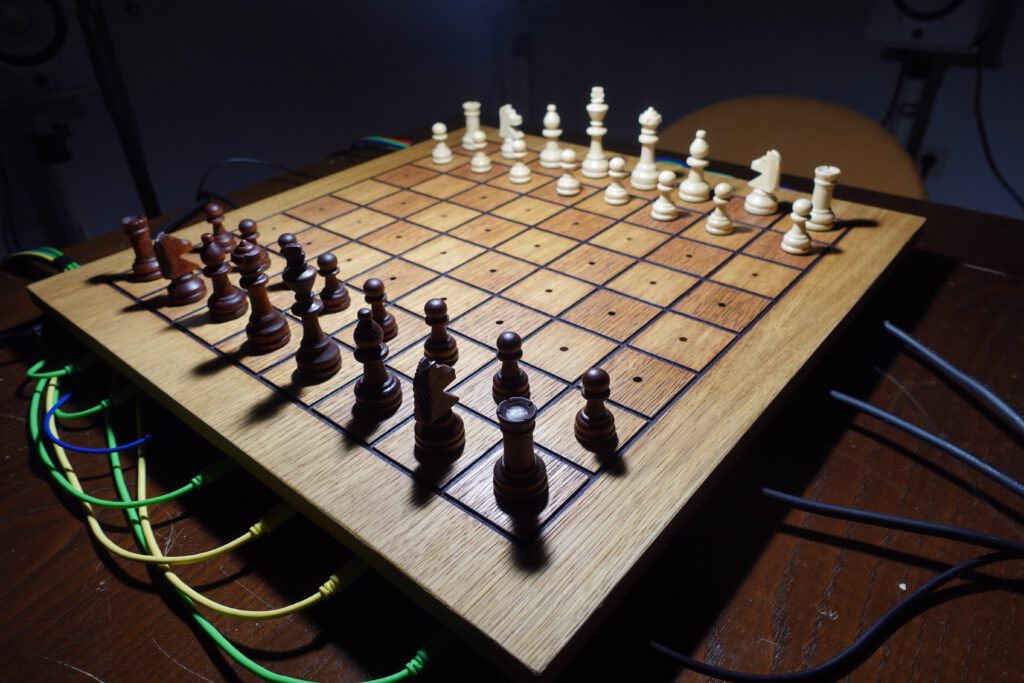
Musical works used in the installative audiowork at Sonoscopia, Porto between 8-9 Dec 2023:
Unreleased works:
Wouter Jaspers – 16 Sinewaves (2023)
Wouter Jaspers – Indeterminate Structures (2023)
Wouter Jaspers & João Ricardo – Outtakes from the Sonoscopia Studio (2023)
Wouter Jaspers – Linear Motion (for bassoon and metal plates) (2022)
Wouter Jaspers – Low (for contrabass clarinet and sinewaves) (2022)
Wouter Jaspers – Variations in 300Hz (2022)
Released works:
Wouter Jaspers & Radboud Mens – Echoes of Nothing (2022) – MFR Recordings (NL)
Preliminary Saturation7 – the house next door (2021) – Muzan Editions (JP)
Wouter Jaspers – Ascent to Shōsan-ji (2020) – Muzan Editions (JP)
Odd Narrative8 – Karl-Marx Straße (2018) – Muzan Editions (JP)
Wouter Jaspers – Air Control (2013) – Vatican Analog (NL)
Wouter Jaspers – Wisdom (2012) – Korm Plastics (NL)
Ezdanitoff9 – Playgrounds (2011) – Silentes (IT)
Ezdanitoff – Komeet (2010) – MOLL (NL)
Preliminary Saturation – Tension Transmission (2008) – Vatican Analog (NL)
Wouter Jaspers – Geigercounting (2008) – Vatican Analog (NL)
Wouter Jaspers – Last Transfer (2007) – Vatican Analog (NL)
Wouter Jaspers – Speaker (2007) – Vatican Analog (NL)
Wouter Jaspers – Resurrection / The Head (2007) – Vatican Analog (NL)
Footnotes:
- Franz Fjödor (Wouter Jaspers) – Geigercounting, Vatican Analog (2008) ↩︎
- Johann Philipp Kirnberger: Der allezeit fertige Polonoisen- und Menuettencomponist. Christian Friedrich Winter, Berlin 1757 ↩︎
- Gerhard Haupenthal: Geschichte der Würfelmusik in Beispielen. 2 Bände. Eigenverlag, Saarbrücken 1994, (Saarbrücken, Univ., Diss., 1994). ↩︎
- Fox, Christopher. “Stockhausen’s plus Minus, More or Less: Written in Sand.” The Musical Times 141, no. 1871 (2000): 16–24. https://doi.org/10.2307/1004650. ↩︎
- Borges, Harald, “Commentary Game and Earnest (1987/89)” CD booklet “Game and Earnest” (oaksmus omH02) ↩︎
- Cross, Lowell, “Reunion: John Cage, Marcel Duchamp, Electronic Music and Chess.” Leonardo Music Journal 1999; 9 35–42. doi: https://doi.org/10.1162/096112199750316785 ↩︎
- Preliminary Saturation is the duo group of Steffan de Turck and Wouter Jaspers (since 2007) ↩︎
- Odd Narrative is the duo group of Hainbach and Wouter Jaspers (since 2016) ↩︎
- Ezdanitoff is the duo group of Frans de Waard and Wouter Jaspers (since 2010) ↩︎
